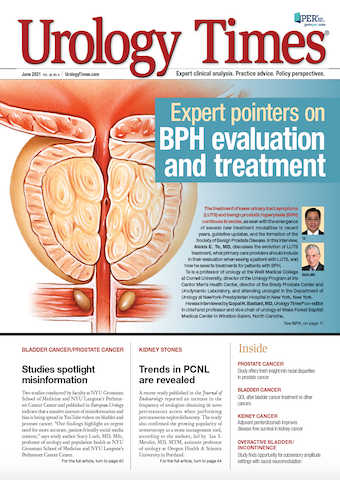Publication
Article
Urology Times Journal
Expert pointers on BPH evaluation and treatment
Author(s):
In this interview, Alexis E. Te, MD, discusses the evolution of LUTS treatment, what primary care providers should include in their evaluation when seeing a patient with LUTS, and how he selects treatments for patients with BPH.
The treatment of lower urinary tract symptoms (LUTS) and benign prostatic hyperplasia (BPH) continues to evolve,as seen with the emergence of several new treatment modalities in recent years, guideline updates, and the formation of the Society of Benign Prostate Disease. In this interview, Alexis E. Te, MD, discusses the evolution of LUTS treatment, what primary care providers should include in their evaluation when seeing a patient with LUTS, and how he selects treatments for patients with BPH.
Te is a professor of urology at the Weill Medical College at Cornell University, director of the Urology Program at Iris Cantor Men’s Health Center, director of the Brady Prostate Center and Urodynamic Laboratory, and attending urologist in the Department of Urology at New York-Presbyterian Hospital in New York, New York.
He was interviewed by Gopal H. Badlani, MD, Urology Times®coeditor
in chief and professor and vice chair of urology at Wake Forest Baptist Medical Center in Winston-Salem, North Carolina.
Q: How has the management of BPH/LUTS evolved over time?
A: BPH/LUTS management really started in the 1990s with the advent of new medical therapies to treat male LUTS [mLUTS] due to BPH. This developed into an evaluation to use these medical therapies to treat BPH and basically focus on the etiology of LUTS in males from BPH. Today, it’s clear that there are more etiologies for LUTS, and mLUTS reflects the other etiologies, especially the nonneurogenic etiologies such as overactive bladder. The original guidelines are from the 1990s. They did not discuss overactive bladder [OAB]. The newer guidelines reflect the addition of medical therapies such as antimuscarinics, β-agonist, and PDE-5 inhibitors. So the guidelines changed/evolved along with those pathways to treating mLUTS. The guidelines have provided an accepted, standard way to say that’s how we manage and treat patients with the current knowledge base of the available literature reviewed and the expertise of the panel.
Q: What should primary care providers include in their evaluation when seeing a patient with LUTS?
A: It helps if they can provide a good summary of the medical history and a complete list of medications and also assess for hypertension, coronary artery disease, neurologic diseases, diabetes, and gastrointestinal issues. If they are on urologic therapies, it’s helpful to know the length and trial of these. It’s good to have a history of their [prostate-specific antigen] if available. A nice history of their lab values and cultures and analysis are also helpful for us.
I don’t expect primary care providers to do [the International Prostate Symptom Score (IPSS)]; they have way too much to do. I like to do [the scoring] in my office when [patients] come in. Honestly, considering the COVID-19 pandemic and greater use of telemedicine, things like the IPSS are probably going to transition to an “e-visit” or “e-check-in” before patients come into the office.
Q: As the guidelines have changed to incorporate more branches such as OAB, have you seen a change in the pattern of medical therapy in terms of combinations?
A: Today, we have a plethora of combinations, and although I do see some of the other combinations being used as primary therapy, especially the OAB medications, my own practice really focuses on the “traditional” BPH therapies. I think the traditional therapies with the best long-term data are still α-blockers and 5α-reductase inhibitors. The OAB medical therapies have been less popular with poor compliance and have a higher risk of retention and cognitive issues in [older patients]. The new β-agonists have become the more go-to OAB medication in urology, but they are expensive and many insurers tend to inappropriately make these patients go to a lower-form cost alternative, which are the antimuscarinics, and accept the potential adverse events [AEs]. I’m not always so comfortable with antimuscarinics, but [they’re] there as an option. [As] long as they know the postvoid residual is low, they can use these OAB medications. But I don’t think that primary care providers should be using antimuscarinics as a primary therapy for mLUTS because it’s easy to send somebody into retention or develop a serious adverse event without proper screening.
Q: What do you think about the use of PDE-5 inhibitors for the treatment of benign prostatic enlargement and/or male LUTS?
A: PDE-5 inhibitors are really an OAB medication in my view since urodynamics studies have shown that they have no impact on relieving bladder outlet obstruction. They work very well in combination, however, with a 5α-reductase inhibitor [5-ARI] to address and balance out the sexual AEs. Studies are in progress to evaluate that combination. If a patient doesn’t tolerate α-blockers, the combination of a 5-ARI and a PDE-5 inhibitor seems to be a good option for medical therapy.
Q: Moving beyond medications, do you think the indications for minimally invasive surgery are different from that being done for an ablative procedure?
A: People throw around the terms “minimally invasive procedure” and “ablative procedure” often. Here is how I classify these procedures. In my view, maximally invasive therapy is an open prostatectomy, and “maximally invasive minimally invasive” procedures are robotic laparoscopic approaches. Those procedures have their risks—such as pulmonary embolus, bleeding requiring transfusion, and increased risk associated with potential cardiovascular instability during these procedures under general anesthesia—so I call them maximally invasive procedures.
The next series are what I would call minimally invasive transurethral procedures, which I would classify as transurethral debulking procedures. The classic one is the monopolar transurethral resection of the prostate [TURP]. There are also new technologies such as bipolar TURP, GreenLight laser, HoLEP (holmium laser enucleation of the prostate), and Aquablation. These are less invasive due to [removing the risk] of dilutional hyponatremia and overall decreased bleeding.
The next minimally invasive category, which is less invasive, are office-based therapies such as transurethral microwave thermotherapy and transurethral needle ablation that have basically been replaced by Rezum, iTind, and UroLift. There are a host of other technologies on the horizon, with many variations of stents. The most important issue in patient selection with these procedures is to determine where the patient would like to get the procedure done, how much risk the procedure poses for them, and whether it is the appropriate procedure for them given their anatomy, need to relieve obstruction, and expected durability of the procedure.
Q: How do you select which treatment to use for a patient?
A: My practice is uniquely focused on BPH/LUTS, and I offer almost all the therapeutic options. Each therapy has advantages and disadvantages [and] are selected based on size and shape and expected outcomes, depending on the studies that have been done. Presence of an intravesical lobe, for example, can have an impact on adverse events such as bleeding, sexual function, catheterization time, and durability.
To pick and choose is a complex, shared decision-making process examining what I would call risk tolerance and benefit outcome analysis related to each procedure. For example, the [maximal] debulking procedures have the best durability and best flow, but they probably have more adverse events, whereas the most minimally invasive procedures really fit the bill for having the least impact on sexual function but [also] the least in relieving obstruction. Patients choose based on their risk tolerance, and that includes an assessment of their medical comorbidities as well.
Of note, procedures approved on studies randomized to placebo-like controls are not equivalent to procedures randomized or well studied against the gold-standard TURP. More importantly, treating prostatic bladder outlet obstruction with a minimally invasive office procedure such as UroLift, iTind, and Rezum [is] clearly not as effective compared to a transurethral debulking procedure or TURP-like procedures.
However, it is clear that these procedures are minimally invasive [because] the multicenter, randomized trials have been compared to placebo controls weaned off medical therapy and are presented in these studies as alternatives to medical therapy. There was a large real-world retrospective study of patients undergoing UroLift.1 In that study, the patients included had smaller glands, were not as symptomatic, and had better flow rates, and those patients had pretty good outcomes overall. I think that only time will tell which one they’ll accept more as being appropriate for our patients and our comfort zone to use them in the office setting. I think the key is the office setting. To be clear, my definition of an office setting is a procedure that does not require IV [intravenous] sedation or general anesthesia and is a purely local anesthesia procedure. Although right now, most of these procedures are probably being done in the ambulatory care unit, more and more will be...done in the office setting.
Q: What about patients who are on an antiplatelet medication?
A: The burden is higher for patients on anticoagulation. But we’re fortunate to have so many minimally invasive procedures that enable us to manage that risk, from laser therapies such as GreenLight to thermotherapy such as vapor ablation or Rezum. This has enabled me, for example, to operate in high-risk patients with maintenance of their anticoagulation status, and there are clearly many good studies validating the GreenLight technology in anticoagulated patients. We, for example, have published data demonstrating the ability to operate on patients on warfarin, and the new AUA BPH guidelines support this option.
Q: What is your approach there? Do you bridge them, or do you operate through warfarin?
A: For patients taking warfarin, I lower their international normalized ratio [INR] to the low 2s and go ahead with the procedure. Regarding other antiplatelet medications, the type of medication dictates when I have the patient stop and restart it. Sometimes I do operate on patients taking antiplatelet medications, and my counseling involves the risk of controlling that bleeding perioperatively and postoperatively. But in general, outcomes have been good. Overall, the big caveat is to have the experience to control and manage bleeding with this technology. At the end of the day, it is the surgeon who has to recognize important arterial bleeding that requires pinpoint fulguration of the arterial bleeder to gain hemostasis at the end of the procedure
Q: Postoperatively, do you use a catheter for a longer duration, or are the patients treated the same way?
A: With warfarin, you know how to control their INRs pretty well and manage the patient. With careful management, you can treat them the same way. With the other anticoagulants, the experience and knowledge with each type will dictate pre-, peri-, and postop management.
Q:Secondary bleeding with laser therapies has been a big issue in the community, sometimes because of undertreatment. In prospective, randomized studies, it doesn’t seem to be a problem, but in the community, secondary bleeding from laser therapy is an issue, particularly ablative lasers as opposed to resection lasers. What is your view on this?
A:My view on those is it’s sort of a mixed bag. In terms of the ablative therapy, if you don’t resect enough, there is a risk of more delayed bleeding. Interestingly, this is also true with standard TURP. You have to resect enough tissue because the obstructive component, especially the residual obstructive component, can cause bleeding. Additionally, one has to vaporize efficiently and limit the coagulation necrosis of remaining tissue. In my view, some patients who have had ablative therapy still had a pretty significant intravesical lobe, and that puts them at risk for recurrent bleeding. You really have to do a complete vaporization procedure in these patients.
Q: What is your advice to a patient who wishes to preserve ejaculation and has a very large gland?
A: For the best long-term outcome, a debulking procedure is best. However, even with these procedures, we’ve modified many of the transurethral approaches with an ejaculatory hood–sparing procedure that reduces the retrograde ejaculation rate to less than 15%. In my practice, a GreenLight procedure or a bipolar, middle lobe–sparing procedure are options to consider. In a very large gland, treating them with a minimally invasive procedure such as Rezum or UroLift will probably have a higher risk of retreatment and secondary procedures later, but that’s something that has to be discussed with the patient with a review of their preoperative assessment to determine how obstructed they are and how much needs to be removed. For example, patients in retention or with high PVR [pulmonary vascular resistance] clearly would do better with a transurethral debulking procedure overall.
Q: So the Aquablation study,2 although not intended to primarily look at it, came out with the statement that ejaculatory function was better than the TURP in randomized controlled trials.
A: That’s exactly what we were talking about. Aquablation is an ejaculatory hood–sparing procedure. I was part of the trials, and that particular procedure was designed with that intention to try to preserve antegrade ejaculation. That particular robotic procedure has what I would call a butterfly template....[T]he robotic template actually spares the ejaculatory duct hood to preserve ejaculation. In that trial, they had a retrograde ejaculation rate of about 11%.
Q: How important is it to perform urodynamics when planning surgery?
A: I tend to do urodynamics for all of my patients, but generally I think it depends on the clinician’s preference, ability to counsel, and how useful it is it to them. I do it because it allows me to confirm bladder outlet obstruction and its severity and the surgical aggressiveness to debulk. It also allows me to counsel on the risk of persistent postop OAB symptoms based on OAB findings during the study. I’ll also be able to assess compliance as well as predict their overall bladder capacity.
It also helps me to counsel the patient on the risk of post-OAB therapies that might be needed and help to identify those patients who have impaired detrusor contractility who might have a higher risk of retention, postvoid residuals, [and] recurrent urinary tract infection....For me, it’s a very good counseling tool that helps me reduce my complication rate and helps me temper expectations based on what I find. A lot of my patients are secondary and tertiary referrals. That may just reflect my own practice. But I think in general, it really helps, but clearly it depends on the clinician being comfortable to use it.
Q: Do you have anything else to add?
A: I think BPH/LUTS is a very good academic portion of urology. We really have had great multicenter, randomized trials and good studies on various new drugs and therapies. We, as the urology community, really try to study the science of it and apply rigorous metrics and new metrics to better understand mLUTS. To promote a widespread understanding to better diagnose, manage, and treat our patients with BPH, several of my esteemed colleagues including Steven A. Kaplan, MD; Claus G. Roehrborn, MD; Kevin T. McVary, MD; Peter Gilling, MD; J. Kellogg Parsons, MD, MHS; Charles Welliver, MD; Kevin Zorn, MD; and myself have founded...the Society of Benign Prostate Disease. We recently had our first virtual international meeting, which covered a range of topics reviewing BPH over the decades, COVID-19, and diversity issues in urology, and [we] are looking forward to our first in-person meeting on September 10 at this year’s AUA annual meeting in Las Vegas. I encourage my fellow urologic colleagues to become members at www.SoBPD.com.
References
1. Eure G, Gange S, Walter P, et al. Real-world evidence of prostatic urethral lift confirms pivotal clinical study results: 2-year outcomes of a retrospective multicenter study. J Endourol. 2019;33(7):576-584. doi:10.1089/end.2019.0167
2. Gilling P, Barber N, Bidair M, et al. Two-year outcomes after Aquablation compared to TURP: efficacy and ejaculatory improvements sustained. Adv Ther. 2019;35(6):1326-1336. doi:10.1007/s12325-019-00952-3




















